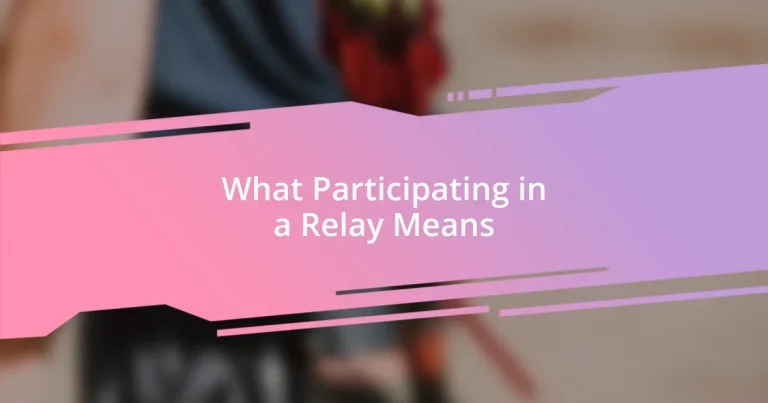Key takeaways:
- Effective communication and trust among teammates are crucial for successful baton exchanges and overall relay performance.
- Each relay team member has distinct roles that significantly impact the race’s outcome, emphasizing the importance of teamwork.
- Celebrating achievements fosters lasting bonds and memories within the team, reinforcing the values of collaboration and resilience.
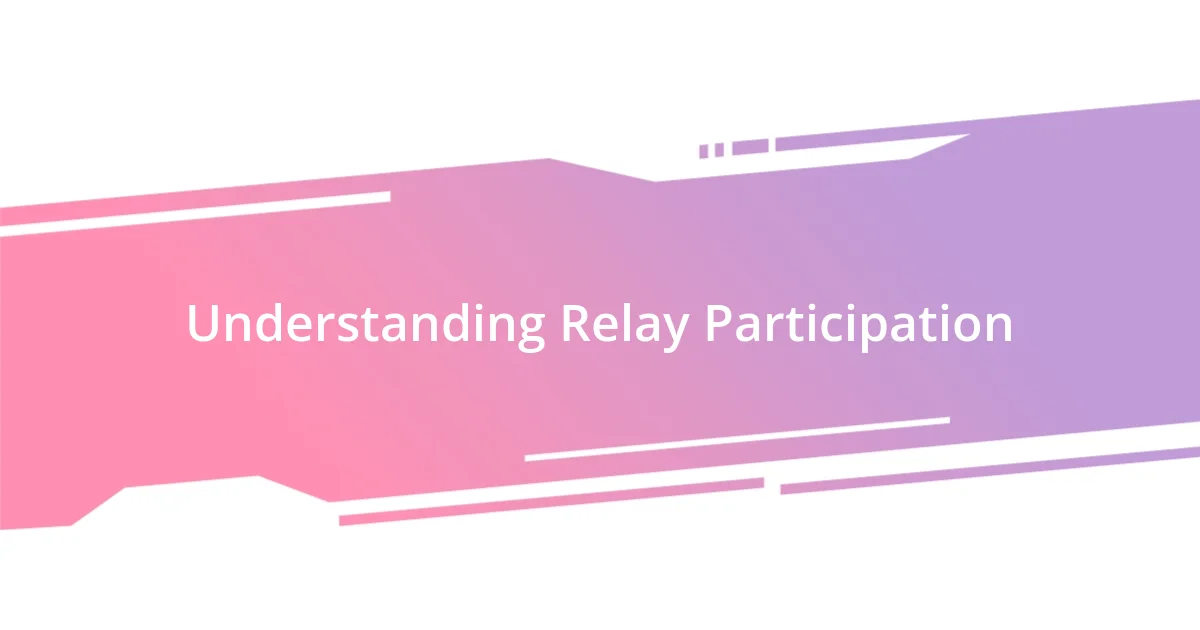
Understanding Relay Participation
Participating in a relay is an experience that goes beyond just running or passing a baton. I remember my first relay; there was a palpable buzz in the air, a mix of nerves and excitement. Have you ever felt the anticipation as you wait for your teammate to approach, knowing that your performance relies on their effort just as much as yours?
When you join a relay, you become part of a tightly-knit team where communication and trust are key. I can still hear my coach reminding us that each leg of the race is like a piece of a puzzle – if one piece falters, the whole picture can be affected. Isn’t it fascinating how a single moment can create a whirlwind of emotions, from thrill to heartbreak, depending on how smoothly things go?
Moreover, relays teach us invaluable lessons about collaboration and shared goals. I recall a race where our team was trailing, yet we encouraged one another, pushing through fatigue with sheer determination. It makes me wonder: how often do we carry the spirit of teamwork from the track into our everyday lives?
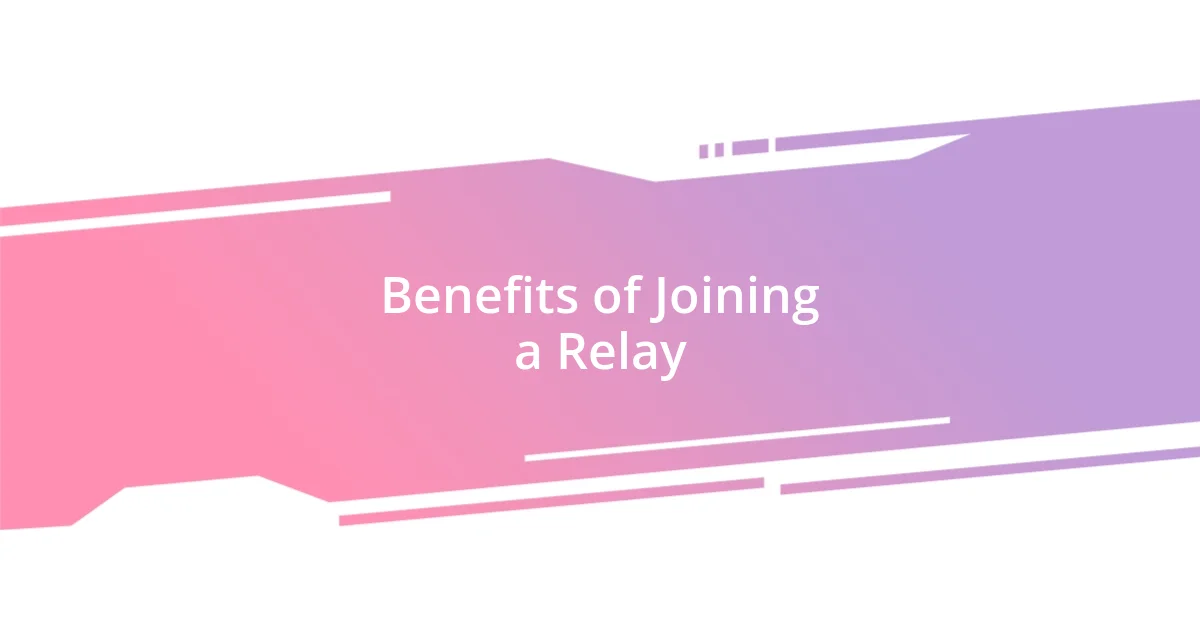
Benefits of Joining a Relay
Joining a relay offers a wealth of benefits that extend far beyond the finish line. In my experience, the most immediate perk is the sense of camaraderie that blossoms among teammates. I remember one particularly grueling practice session when we were all exhausted and doubting our abilities. However, we spent that time encouraging each other, sharing laughs, and ultimately discovering our strength through unity. There’s something truly heartwarming about knowing you’re not in it alone; every cheer and high-five fuels your determination to push harder.
Here are some key benefits of joining a relay:
- Teamwork Skills: You learn how to effectively communicate and collaborate with others.
- Physical Fitness: Training for a relay can enhance your overall fitness and stamina.
- Mental Resilience: Overcoming challenges as a group builds confidence and mental fortitude.
- Sense of Accomplishment: Completing a relay is exhilarating, reinforcing commitment to shared goals.
- Lifelong Friendships: The bonds formed during your relay journey often become lasting friendships.
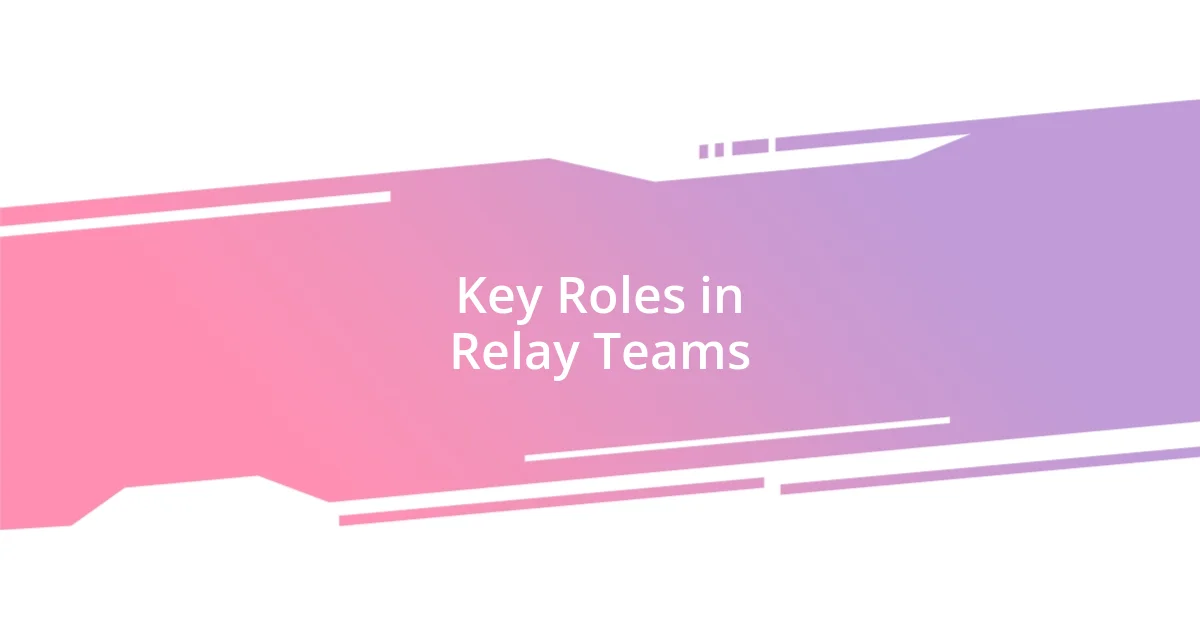
Key Roles in Relay Teams
Each member of a relay team plays a distinct and vital role that contributes to the overall success of the race. The starter, for instance, sets the tone right from the beginning, igniting the energy of the event with their performance. I still recall a teammate who thrived under pressure, launching us into the race with a blistering pace that invigorated everyone. Do you remember the feeling of flying off the blocks, fueled by the adrenaline of competition? It’s truly exhilarating.
The runners in between also hold crucial responsibilities. Their performance can elevate the team or create challenges, making seamless baton exchanges even more critical. I often think back to a relay where one of our middle runners faced a steep hill; the way they pushed through that moment, making the baton exchange fluid and flawless, was a testament to our training. It’s in these moments that the bonds among teammates solidify, as we share both triumphs and difficulties.
As for the anchor, they’re the ones who cross the finish line, often under intense pressure. I remember the thrill of watching our anchor tackle that final leg, their determination radiating from the track. The crowd’s roar mixed with my heart’s pounding echo is a memory I’ll treasure forever. Who wouldn’t want to be part of a dramatic climax where every second counts and everyone’s hopes ride on one person’s performance?
| Role | Responsibilities |
|---|---|
| Starter | Sets the pace and tone for the race |
| Middle Runners | Maintains speed and performs baton exchanges |
| Anchor | Delivers the final sprint and finishes the race |
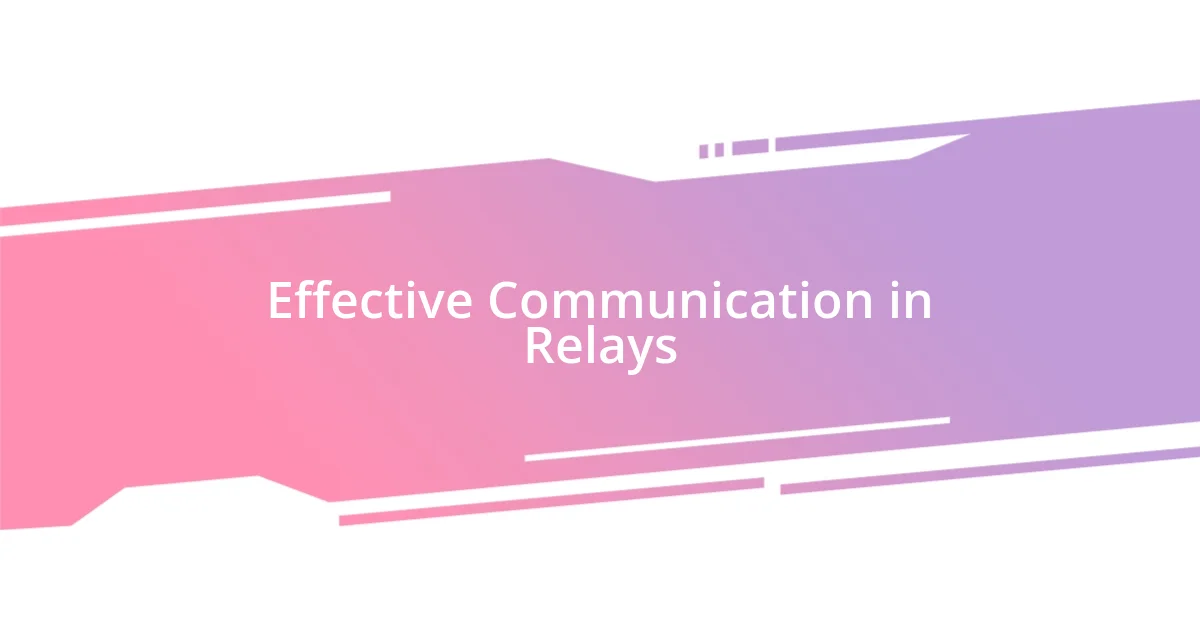
Effective Communication in Relays
Effective communication in relay teams is paramount for success. I still remember a particular race where the difference between winning and losing hinged on our last-minute strategy discussion. It was amazing how a few words exchanged before the race transformed the atmosphere; clear expectations helped everyone perform their best. Have you ever experienced that rush when everyone is on the same page? It’s like a synchronized dance where every move counts.
Baton exchanges stand out as one of the most critical moments where communication truly shines. I recall one practice session that seemed to drag on. It wasn’t until we spent time practicing our non-verbal cues that everything clicked into place. Suddenly, it was as if we could read each other’s minds! This open dialogue about body language and timing made each exchange seamless and less stressful. Just imagine the thrill when your teammate nails that handoff without breaking stride.
Experience has taught me that effective communication also extends beyond the track. It’s about fostering trust and support within the team. Knowing you can count on one another provides a safety net during intense moments. Have you ever felt that wave of assurance when your teammate encourages you right before your leg of the race? That unspoken bond carries immense weight and turns even the toughest runs into shared victories.

Training Strategies for Relay Success
Training for relay success involves a blend of physical and mental strategies that can elevate a team’s performance. I remember how we meticulously broke down our practices into segments, focusing not just on speed but also on endurance. For example, during our long runs, we would enact race scenarios to simulate baton exchanges, enabling each runner to find their rhythm under different conditions. It was enlightening to see how these drills helped us prepare for the unexpected; we were not just running but strategizing together.
In addition to physical training, mental preparation is equally critical for relay success. Visualization techniques work wonders. I often found myself picturing the perfect baton handoff while lying in bed the night before a race. Have you ever imagined a moment so vividly that it almost felt real? That kind of mental rehearsal boosted my confidence and reduced anxiety—it felt as if I had already experienced the race. Sharing these visualization exercises with teammates created a collective mindset, allowing us all to thrive under pressure.
Another valuable strategy is establishing a consistent training schedule. I learned firsthand that maintaining regularity in practice not only builds fitness but strengthens team dynamics. There was a time when we encountered conflicting schedules, and it felt disjointed, like a band playing out of sync. Eventually, we found a rhythm that worked for everyone. Do you know that satisfaction when all the pieces come together? It’s not just about workouts; it’s about commitment to one another as well, and that unity often translates to success on race day.

Overcoming Common Relay Challenges
One of the biggest challenges in a relay is managing the pressure during the baton exchange. I vividly recall a moment in a crucial race when my heart raced not just from sprinting but from the fear of fumbling the baton. That anxious feeling can be overwhelming, but channeling that energy into focus transformed the moment. Have you ever felt that surge of adrenaline turning into a fuel that pushes you to perform better? Instead of letting the worry take over, I learned to embrace it and trust the countless hours of practice leading up to that relay.
Another hurdle we often faced was maintaining our pace during the handoff. It’s all too easy to get caught up in the moment and either slow down or speed up, which can throw everything off. I remember one practice where our coach introduced a rhythm count for each exchange. It felt strange at first—like a choreographed dance—but gradually, it became second nature. Has there ever been a technique that just clicked for you? This method not only made the transitions smoother, but it also created a shared sense of anticipation and teamwork that fueled our speed.
Miscommunication can trip up even the most well-prepared teams. I recall a relay where my teammate called out too early, and I surged ahead only to find no baton in hand. It was frustrating, but it led to a pivotal team discussion about timing and clarity. Have you experienced miscommunication in a big moment? We then developed a clear set of signals to ensure everyone was on the same wavelength during races. Skillful adjustments to our communication made all the difference, allowing us to learn from our mistakes and move forward together, stronger than before.
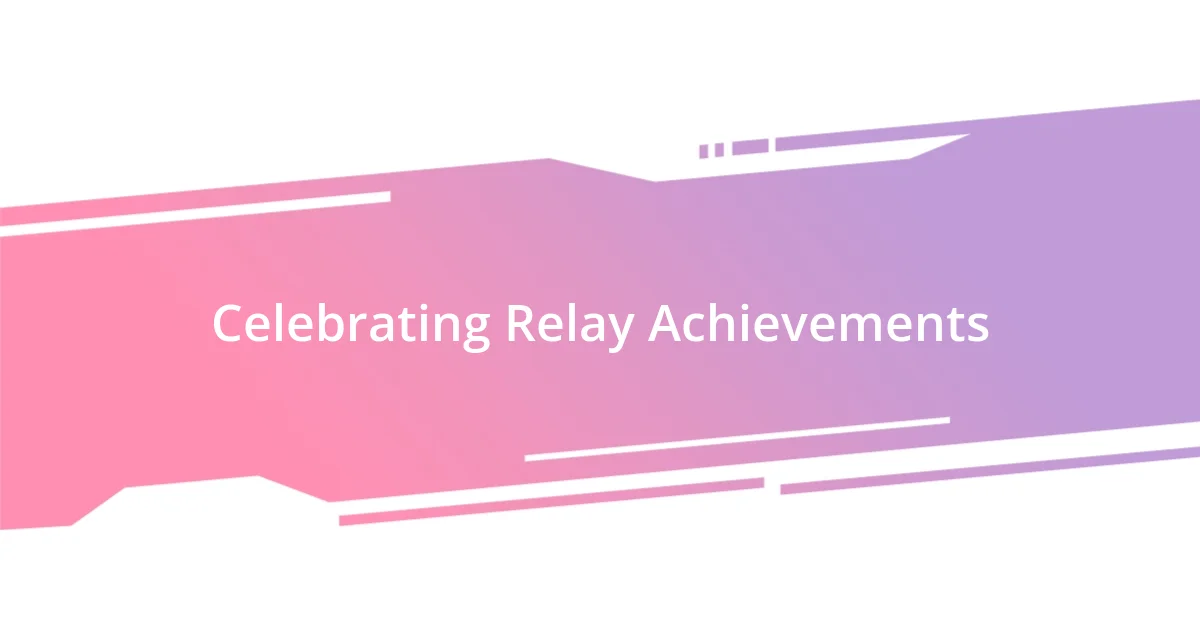
Celebrating Relay Achievements
Celebrating relay achievements is a time of joy and reflection. I recall crossing the finish line in my final high school relay—it felt like an explosion of emotions, a culmination of all those early mornings and late nights spent training. When we won, it wasn’t just about the trophy; it was about the countless moments of teamwork and friendship that had led us there. Have you ever experienced such an overwhelming wave of pride that it almost takes your breath away?
Each relay victory is a unique story, marked by individual contributions that deserve recognition. I remember when one of my teammates, who had struggled with confidence, soared in a pivotal race, outperforming everyone’s expectations. Watching her embrace that victory, tears streaming down her face, reminded me that every achievement, no matter how small, is worth celebrating. Isn’t it incredible how sport can unveil strength and resilience in us that we didn’t even know existed?
Moreover, I’ve learned that celebrating achievements goes beyond just the medals; it creates lasting memories. After one successful relay season, we had a small gathering to honor everyone’s contributions, and we shared our stories and favorite moments. Those nights filled with laughter, reflections, and even a few tears created bonds that lasted long after the races ended. Have you ever had a moment where you felt truly connected with your team? By fostering this sense of achievement, we not only celebrated our victories but also solidified the friendships that define our relay experiences.












